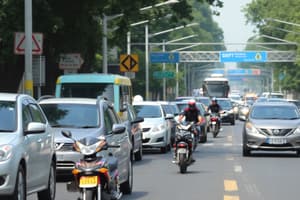Podcast
Questions and Answers
What defines the Level of Service (LOS)?
What defines the Level of Service (LOS)?
- A measurement of vehicle emissions on roadways
- A quantitative measure of traffic speed
- A qualitative measure of operating conditions and driver perception (correct)
- A simulation of traffic flow under ideal conditions
Which Level of Service indicates congested flow?
Which Level of Service indicates congested flow?
- Level E
- Level A
- Level C
- Level F (correct)
Which factor is NOT considered in evaluating Level of Service?
Which factor is NOT considered in evaluating Level of Service?
- Traffic accident rates (correct)
- Traffic interruptions & restrictions
- Operating speed & travel time
- Driving comfort
Which Level of Service is characterized by little freedom to maneuver?
Which Level of Service is characterized by little freedom to maneuver?
Which factor may affect the capacity and Level of Service on a roadway?
Which factor may affect the capacity and Level of Service on a roadway?
What characterizes Level C in terms of driving conditions?
What characterizes Level C in terms of driving conditions?
What is NOT a factor influencing the Level of Service?
What is NOT a factor influencing the Level of Service?
What is the primary effect of roadway condition on Level of Service?
What is the primary effect of roadway condition on Level of Service?
Flashcards are hidden until you start studying
Study Notes
Level of Service (LOS)
- LOS is a measure of traffic stream conditions and driver/passenger perception.
Factors Considered in Evaluating LOS
- Operating speed and travel time
- Traffic interruptions and restrictions
- Freedom to maneuver
- Driving comfort
- Operating cost
Six Levels of Service
- Level A (Free-Flow): High physical and psychological comfort.
- Level B (Stable Flow): Reasonable level of physical and psychological comfort.
- Level C (More Restrictions): More restrictions than Level B, tension noticeable.
- Level D (Unstable Flow): Approaching unstable conditions, little freedom to maneuver.
- Level E (Unstable Flow): Maneuverability is extremely limited.
- Level F (Congested Flow): Road segment used above designed capacity.
Factors Affecting Capacity and Level of Service
- Roadway condition
- Lane width
- Laterals
Studying That Suits You
Use AI to generate personalized quizzes and flashcards to suit your learning preferences.




